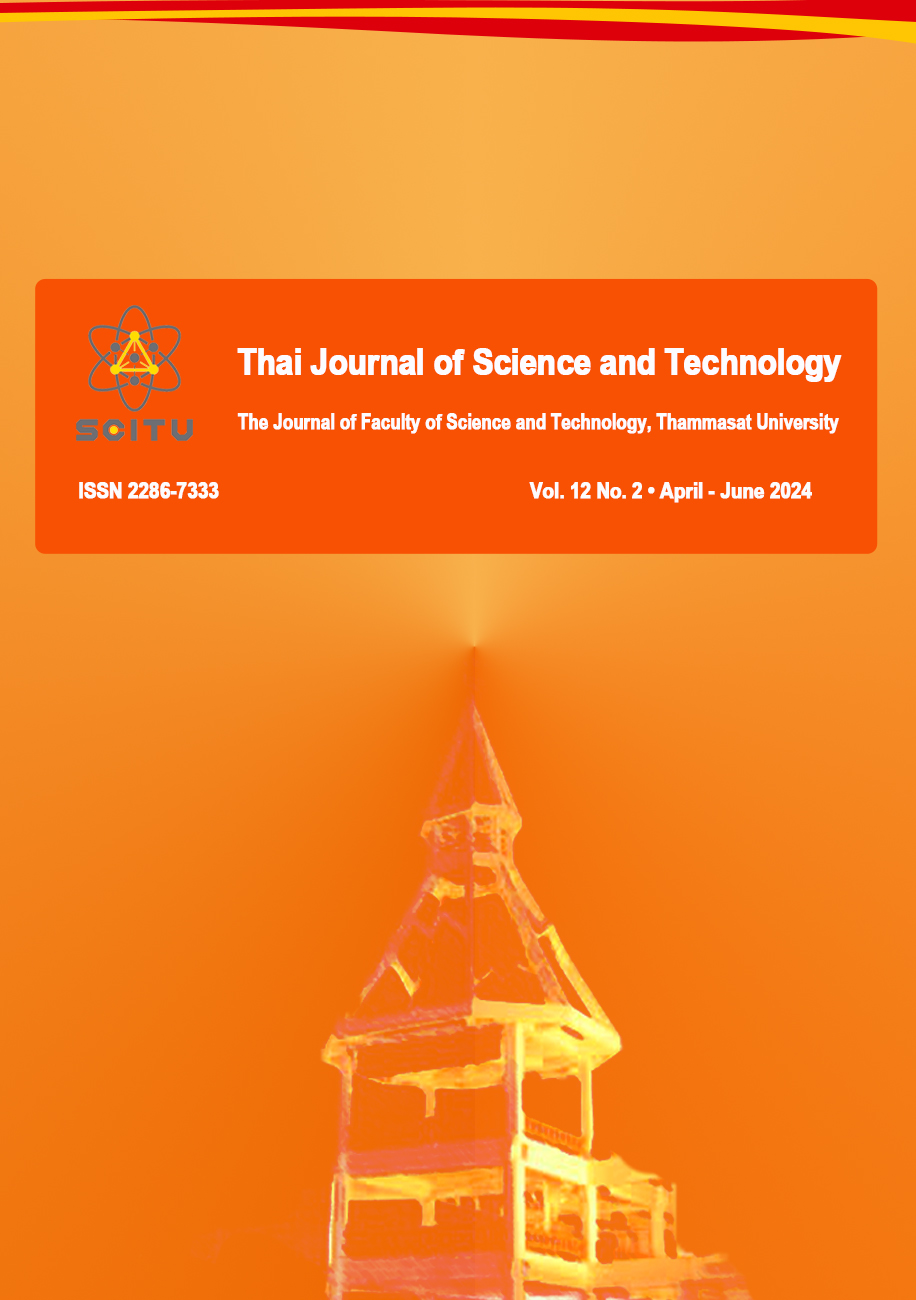Effect of Plant Growth Regulators on Yield and Chemical Composition of Cananga fruticosa x odorata Flowers
Main Article Content
Abstract
The utilization of plant growth regulators to stimulate the number of flowers and investigating the key chemical constituents of the Cananga fruticosa x odorata flowers in Nakhon Ratchasima Province. The experimental design employed in this study is a randomized complete block design (RCBD), consisting of six treatments, each replicated five times. The treatments include T0 (Control), T1 (PBZ: Cytokinin), T2 (PBZ: Ca), T3 (PBZ: Mg), T4 (Cytokinin: Ca), at a ratio of 1:1 per liter. and T5 (Cytokinin: Ca: Mg) at a ratio of 1:1:1 per liter. Applying every 15 days after planting for a period of 2 months by recorded flower count and fresh flower yield every 15 days for a total of 5 observations. It was observed that at the age of 105 days, treatments T2 and T4 exhibited the highest flower counts, with 64 flowers per plant each. Additionally, the fresh flower yield was found to be 89.91 grams and 86.79 grams, respectively. There was a difference compared to the control group, which had the lowest flower count and the lowest flower yield. This indicated that the use of plant growth regulators and plant nutrients has an effect on stimulating Cananga fruticosa x odorata flowers to produce more abundant flowers. From the study of chemical components in Cananga fruticosa x odorata essential oil, it was found that there are a total of 47 significant components. The majority of these components belong to the Terpenes group, which are compounds responsible for the distinctive aroma. These compounds have various potential industrial applications.
Article Details

This work is licensed under a Creative Commons Attribution-NonCommercial-NoDerivatives 4.0 International License.
บทความที่ได้รับการตีพิมพ์เป็นลิขสิทธิ์ของคณะวิทยาศาสตร์และเทคโนโลยี มหาวิทยาลัยธรรมศาสตร์ ข้อความที่ปรากฏในแต่ละเรื่องของวารสารเล่มนี้เป็นเพียงความเห็นส่วนตัวของผู้เขียน ไม่มีความเกี่ยวข้องกับคณะวิทยาศาสตร์และเทคโนโลยี หรือคณาจารย์ท่านอื่นในมหาวิทยาลัยธรรมศาสตร์ ผู้เขียนต้องยืนยันว่าความรับผิดชอบต่อทุกข้อความที่นำเสนอไว้ในบทความของตน หากมีข้อผิดพลาดหรือความไม่ถูกต้องใด ๆ
References
Barker, V.A., & Pilbeam, J.D. (2015). Handbook of Plant Nutrition. CRC Press Taylor, New York. 1, 1-774.
Bennett, W.F. (2008). Nutrient Deficiencies and Toxicities in Crop Plants. Cambridge University Press, USA. 202 pages.
Chalermklin, P. (2016). Hybrids of the ylang-ylang family. Agricultural housing, 1, 195-199. doi: file:///C:/Users/hp/Downloads/TAB000125600420c.pdf.
Chatpaisarn, A., Laohakunjitn, N., & Kerdchoechuen, O. (2010). Identification of Components Michelia alba DC. Essential Oil by Solid-Phase Micro Extraction Head Space Gas Chromatography Mass Spectrometry. Agricultural Science Journal, 41(3), 641-644.
Ferber, S.G., Namdar, D., Hen-Shoval, D., Eger, G., Koltai, H., Shoval, G., Shbiro, L., & Weller, A. (2020). The "Entourage Effect": Terpenes Coupled with Cannabinoids for the Treatment of Mood Disorders and Anxiety Disorders. Current neuropharmacology, 18(2), 87-96. doi: 10.2174/1570159X17666190903103923.
Guzman, S.L., Bonilla, H., Gomez, R., & Reyes, R. (2015). Linalool and β-pinene exert their antidepressant-like activity through the monoaminergic pathway. Life Sciences, 128(1), 24-29. doi: 10.1016/j.lfs.2015.02.021.
Hirschi, K.D. (2004). The calcium conundrum. Both versatile nutrient and specific signal. Plant Physiology, 136(1), 2438-2442. doi: https://academic.oup.com/plphys/article/136/1/2438/6112388.
Hopkins, W.G., & Huner, N.P.A. (2008). Introduction to Plant Physiology, 4th edition. Wiley Texbooks, 528p.
Jiramonkolkarn, U. (2022). Collection of fragrant flowering plants. Amarin Printing and Publishing, Baan Lae Suan Publishing House. 264 p.
Phatin, R., Kanlayawatanakul, M., & Laorit, N. (2009). Aromatherapy and essential oils in the Thai spa business. Isaan Journal of Pharmacy, 5(2), 160-166.
Pierik, R. (1997). In vitro Culture of Higher Plants. Martinus Nijhoff Publishers, Netherland. 344 p.
Punjee, P., Dilokkunanant, U., Sukkatta, U., Vajrodaya, S., Haruethaitanasan, V., Pitpiangchan, P., & Rakthaworn, P. (2009). Scented extracts and essential oil extraction from Michelia alba D.C. Proceedings of 47th Kasetsart University Annual Conference: Science. (p.p. 404-411). The Thailand Research Fund, Bangkok (Thailand).
Russo, E.B. (2011). Taming THC: Potential cannabis synergy and phytocannabinoid-terpenoid entourage effects. British Journal of Pharmacology, 163(7), 1344–1364. doi: https://www.ncbi.nlm.nih.gov/pmc/articles/PMC3165946/.
Sillapavisal, W., & Netmueang, N. (2015). The Study of Chemical Compositions and Antibacterial Activity of Flower and Leaves in White Champaka (Michelia Alba D.C.). In Proceedings of 12th Kasetsart University Annual Conference: Science. Kasetsart University, Bangkok.
Thongampai, P. (1994). Plant hormones and synthetic substances. Wichai Printing, Bangkok. 196 pages.
White, P., & Broadley, M. (2003). Calcium in Plants. Annals of botany, 92(4), 487–511. doi: 10.1093/aob/mcg164.


